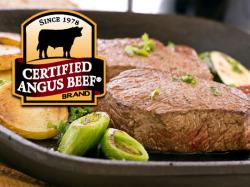CAB Momentum Pays Record Premiums
February 17, 2014 | 3 min to read

Market premiums paid for cattle that earn the Certified Angus Beef ® (CAB®) brand trademark more than doubled recent annual totals to reach the neighborhood of $50 million.
The brand’s 10 years of increasing demand and seven years of sales records left some Angus producers wondering how that affects their bottom line. Results from the biennial survey of CAB-licensed packers in January shines a halogen beam on the answer.
There were plenty of hints. In 2011, a 45% increase in grid premiums to $32.3 million did not in itself constitute a trend. But USDA’s mandatory reporting, never known for overstating, showed 2012 starting with a CAB premium of $8 per hundredweight (/cwt.).
Apparently, that mark was often revisited in 2012 to bring about the 60% single-year further increase to a record $51.6 million paid. The previous record of almost $40 million was 10 years earlier in a turbulent world market affected by bovine spongiform encephalopathy (BSE or “Mad Cow Disease”) and trade barriers (See charts).
The $47 million in CAB premiums paid in 2013 was more than double the $22.9 million paid in 2010.
All of the data comes from CAB’s “Here’s the Premium” project that has surveyed packers to gather total dollar grid premiums paid since 1998. They report totals for the aggregate, and although Certified Angus Beef LLC tracks volume sold by packer, it does not know the share of cattle each buys on a grid.
The top four CAB packers produced more for the brand in each of the past two years and paid record amounts to producers. Even as cattle numbers have declined, more and more sell on value-based grids that pay direct CAB premiums. The share of live cash trade to grid, contract or formula pricing moved from a balance in 2005 to 67% grids by 2011 and last year Cattle-Fax reported that number at 76.9%.
Boxed beef prices were a concern for commodity producers early in the last decade, as the trend line for USDA Choice beef met resistance at $150/cwt. Some saw that as a sign to forget trying to please consumers and focus on cost cutting. Others focused on making beef worth a higher price. CAB cutout climbed higher across five years, from less than $147/cwt. in 2009 to more than $203/cwt. last year. (See table)
Packers say their cash bids reflect estimates of potential for CAB and USDA Prime grading cattle, too. Regardless of how the cattle are sold, premium quality pays.
“Demand for branded and premium products from the consumer has increased as the economy has improved, and food service is probably the biggest winner,” says Alan Smith, director of protein research and risk management for CattleFax.
“Given higher prices, consumers want more assurances of a good eating experience and are willing to pay for it,” he says. “Everyone who handles or supplies the premium product sees revenue or margin gains.”
Missouri economist Scott Brown agrees. “The work invested over the years has resulted in CAB’s position as a brand consumers trust for a consistent and great eating experience,” he says. As all beef prices push still higher Brown says, “the market advantage for CAB, and that momentum, will only accelerate.”
Looking at CAB grid premiums paid over time, it took nearly 30 years to garner half of the $450.8 million paid for the share of 40 million CAB-accepted cattle sold on grids, while nearly 30% of that total was paid in the last three years.
Brown says it’s important for Angus producers to keep their focus. Balancing supply and demand has been a CAB hallmark for 35 years, but at the scale of selling 865 million pounds per year, much hangs in the balance.
“If demand for CAB product outstrips supply, consumers will begin to search for alternatives,” he says. “It’s clear that Angus producers’ focus on genetics that include marbling has put money in their pockets, but they must work to ensure there is an adequate supply, or risk losing those premiums.”
Of course, most producers don’t own their calves through the finishing phase, but information has integrated the market so that some premium reaches everyone who makes the effort to aim for quality. Dividing total CAB grid premiums over the last few years by the number of cattle accepted for CAB equates to nearly $15 per head, but many ranchers realize more like $15/cwt. (See related story).
On the other hand Brown says, “You can begin to see the end of the market for average cattle in this country,” other than growing discounts. But solutions are in reach: “Advances in genetic prediction and breeding technologies make a step up to premium production an easy and relatively low-cost prospect for most commercial producers.”
Source: Certified Angus Beef ® brand
